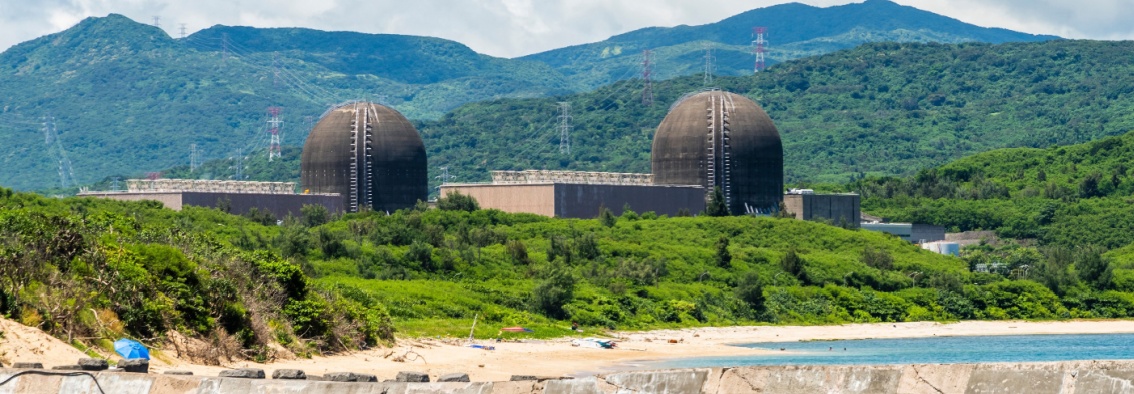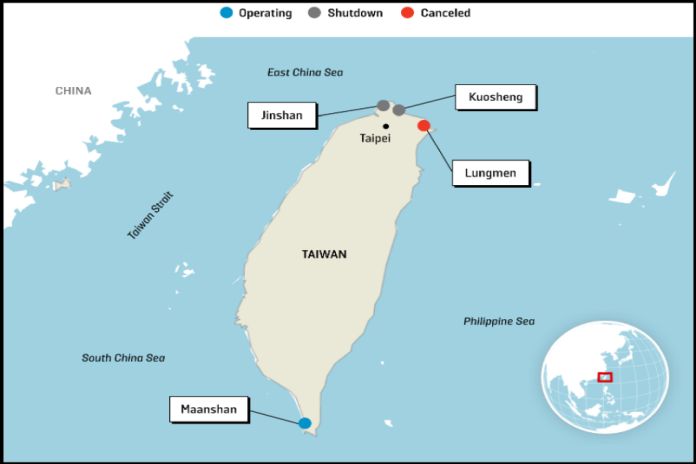In the 1970s, during a period of rapid industrialization and economic growth, and lacking significant natural energy resources, Taiwan began to rely on nuclear energy. By the mid-1980s, Taiwan had established three nuclear power plants with six active reactors: Jinshan (金山), Kuosheng (國聖), and Maanshan (馬鞍山). (A fourth plant in the northeast, Lungmen (龍門), never became fully operational.) These nuclear power plants were integral to the nation’s energy mix, accounting for 52.4 percent of all electricity consumed during its peak in the 1980s. Nuclear energy generation increased significantly in 1982 and continued to rise at a similar rate until 1987.
The Democratic Progressive Party’s (DPP, 民進黨) vision of creating a “nuclear-free homeland” by 2025 is central to Taiwan’s national debate on energy policy. This vision was written into law in 2017 with an amendment to the Electricity Act (電業法), which states that Taiwan’s nuclear reactors must be shut down as their 40-year licenses expire. As of today, Maanshan is the only operating nuclear power plant in Taiwan, and the decommissioning of unit 1 (also known as the Third Nuclear Power Plant) in Pingtung County (屏東縣), started as scheduled on July 27, 2024 with the expiration of its operating license.
The government’s broader energy strategy aims to phase out nuclear energy, with production gradually decreasing over the years: in 2023, it accounted for only 6.3 percent of produced energy. The replacements would be a mix of 20 percent renewable energy, with the rest made up of liquefied natural gas (LNG) and coal by 2025. By 2023, Taiwan had achieved a mix of 9.5 percent renewable energy, 39.5 percent LNG, and 42.2 percent coal.
Energy security: The core of the debate
Despite these clear goals, the policy has faced significant criticism, with the main argument being that the energy transition plan is overly ambitious and may compromise Taiwan’s energy security. In recent years, the fragility of Taiwan’s energy security has also been exacerbated by a series of power outages, which fuel public anxiety about the reliability of the nation’s energy grid. For example, the June 15 power outage on Liuqiu Island (小琉球) during peak tourist season, which caused significant financial losses for local businesses, highlights the challenges of maintaining a stable power supply.
Following these issues, state-run Taiwan Power Company (Taipower, 台灣電力公司) President Wang Yao-ting (王耀庭) offered his resignation, demonstrating that there was significant public and political pressure regarding the lack of power supply stability. However, Wang was encouraged to remain in the position.
A stable and reliable power supply is essential for maintaining economic growth and ensuring the well-being of Taiwan’s population. Taiwan’s technology sector, including giants like Taiwan Semiconductor Manufacturing Company (TSMC, 台灣積體電路製造股份有限公司), relies heavily on a stable and affordable power supply. Any disruptions or significant increases in energy costs could have ripple effects across the economy, potentially undermining Taiwan’s competitive edge in the global market. The government’s strategy to phase out nuclear power—while increasing reliance on renewable energy, and fossil fuels such as LNG—raises concerns about the long-term sustainability and security of the island’s energy supply. As of 2023, renewable energy accounted for 9.5 percent of Taiwan’s total electricity generation, far below the government’s target of 20 percent by 2025.
Additionally, the withdrawal of multiple Japanese companies from Taiwan’s renewable energy market in 2023 further highlights the industry’s difficulties. This shortfall has heightened public concerns about the feasibility of the government’s energy transition plan.
The societal divide
Taiwan’s debate over nuclear energy has seen divided public opinion on energy security and the potential risks of nuclear energy. This division intensified following the 2011 Fukushima Daiichi disaster in Japan. That catastrophic nuclear reactor meltdown increased global fears about the safety of nuclear power and had a profound impact on public opinion in Taiwan.
As a densely populated island prone to natural disasters, Taiwan became acutely aware of the potential dangers of nuclear power. The DPP capitalized on this public sentiment, embedding its “nuclear-free homeland” policy into the national agenda, which resonated strongly with a public increasingly wary of nuclear risks.
Additionally, nuclear waste management is among the most contentious issues in the nuclear debate. The Taiwanese government has faced criticism for its poor handling of nuclear waste, especially when it comes to the decision to store low-level radioactive waste (LLRW) on Orchid Island (Lanyu or 蘭嶼). The Taiwanese government began storing nuclear waste on Orchid Island in 1982 without adequately informing or obtaining consent from the Tao people—who were initially told the facility would be a fish cannery, not a nuclear waste storage site.
Moreover, reports have highlighted that nuclear waste has been stored in damaged, leaking barrels, raising serious safety and environmental concerns. Overall, Taiwan has struggled to find permanent disposal solutions for LLRW – and this has contributed to the public’s distrust of the government over the safety of nuclear energy, and created a negative perception of nuclear energy. Additionally, public concerns appear to be growing. In November 2018, a referendum question on nuclear power in Taiwan showed apparent support from 59 percent of voters for maintaining the island’s nuclear power energy beyond 2025. In contrast, the 2021 referendum addressing whether to restart the construction of the Lungmen Nuclear Power Plant (the fourth nuclear power plant) was rejected with only 41 percent of voters supporting the restart.
Without nuclear energy, Taiwan would need to significantly increase its reliance on fossil fuels, leading to substantial carbon emissions. This shift would also necessitate an increase in fossil fuel imports, subjecting Taiwan’s energy supplies to global price volatility and supply chain disruptions and making them a less stable energy source than domestically produced nuclear power. This overreliance on imported fossil fuels will compromise Taiwan’s energy security, and conflict with the government’s objectives of reducing carbon emissions and addressing climate change.
Additionally, public opinion surveys indicate strong support for renewable energy sources. For instance, a recent study found that 83.7 percent of Taiwanese respondents favored renewable energy options such as solar, wind, and hydropower, while only 2.8 percent supported fossil fuels. [1] In short, Taiwanese society is deeply divided over nuclear energy and is influenced by safety concerns, environmental risks, and the desire for sustainable energy solutions.

Rethinking nuclear safety and innovation
Given the challenges of phasing out nuclear power, Taiwan should reconsider its approach. Instead of an immediate phase-out, the government could prioritize enhancing the safety of its current nuclear infrastructure and explore advanced technologies. As President Lai Ching-te (賴清德) mentioned at the National Climate Change Response on August 8, the government intends to promote the diversification of forms of green energy—including new emerging and advanced nuclear energy technologies. This is a possible sign that discussions reevaluating the risks and benefits of nuclear energy have already begun.
Japan, similarly to Taiwan, is also prone to natural disasters and Japan’s frequent seismic activity has not resulted in a decision to phase out nuclear energy. Instead, it has significantly improved nuclear safety, particularly with small modular reactors (SMRs). These reactors, which are smaller, more flexible, and equipped with passive safety features, could be a viable option for Taiwan. They require less land and integrate well with renewable energy sources, offering a stable, low-carbon power supply. By investing in SMRs, Taiwan could enhance nuclear safety while gradually transitioning to renewables without compromising energy security. However, despite these safety improvements, their most significant disadvantage is that SMRs still generate radioactive waste of spent nuclear fuel that requires long-term management.
A potential solution for Taiwan’s energy challenges and nuclear waste management could be adopting molten salt reactor (MSR) technology, mainly by using thorium-based reactors. China is progressing in this area, with plans to build a thorium reactor in the Gobi Desert starting in 2025. Thorium, a naturally occurring radioactive element, must first be converted to U-233 in a reactor to produce nuclear energy. These reactors use liquid salt or carbon dioxide for cooling instead of water, significantly reducing the risk of meltdowns. Taiwan could consider using similar technology to diversify its energy sources.
Additionally, this technology would also significantly reduce the risks of nuclear meltdowns, making the public more likely to accept this technology. Compared with traditional nuclear reactors, SMRs and MSRs offer enhanced safety. However, the SMRs, due to their smaller size, may have a higher cost per unit, and MRSs with advanced materials and technology may be costly initially, but the cost will be rewarded through long-term efficiency.
Taiwan’s potential adoption of advanced nuclear technologies like SMRs and MSRs could bolster energy security, safety, and environmental sustainability. By re-evaluating its nuclear energy strategy and exploring innovative reactor designs, Taiwan could diversify its energy mix, enhance efficiency, align with the net-zero emission goal by 2050, and build greater public acceptance of nuclear power.
The main point: While the government has set ambitious targets for renewable energy, these sectors have underperformed, leading to an overreliance on fossil fuels. Considering Taiwan’s geographical limitations, there are fewer choices for energy diversification, and the most feasible energy production is nuclear energy. To ease the citizens’ worries over the safety of nuclear energy, the government needs to invest in advanced nuclear technologies, enhance the safety of its existing nuclear infrastructure and nuclear waste management. At the same time, a gradual transition to renewable energy, supported by regional cooperation and innovation, can help Taiwan build a more resilient, safe and sustainable energy system.





